Birds with white-colored patches on their wings are some of the most beautiful in the world. In Western culture, white symbolizes purity, peace, cleanliness, and perfection.
That’s why seeing one in nature can make your day 10 times better.
The list of birds with white stripes on wings includes the lesser nighthawk, northern mockingbird, killdeer, Eurasian magpie, lark bunting, tricolored blackbird, swamp boubou, and many others.
Let’s jump straight in and see what 25 species of white-wing-striped birds look like.
Table of Contents
25 Birds With White Stripes On Wings
Lesser Nighthawk

Scientific name: Chordeiles acutipennis
Lifespan: 4-5 years
Wingspan: 21.5 in
Wing Stripes: Broad white wing stripes close to wingtips
Native to: South America, North America, and Central America
These small nighthawks with rounded wings and fairly long notched tails can be often seen flying low over deserts and grasslands at dusk.
Lesser Nighthawks are camouflaged by their “earthy” colored plumage and only in flight, can you see their distinctive bar across the wingtips. This stripe is white in males and cream-colored in females.
The Lesser Nighthawk looks similar to Common Nighthawk – the best way to distinguish them is by the position of the white wing patch: it is closer to the wingtip on the Lesser and closer to the base of the wing on the Common Nighthawk.
Lesser Nighthawks are known for their erratic, bat-like flying technique, graceful loops, and frequent direction changes during flight.
These birds breed across Northern and central California, Nevada, and southwestern Utah south across New Mexico, Arizona, and Texas, and into Mexico.
Females will not make nests but lay eggs directly on the ground, using their camouflaged bodies to keep the eggs hidden. These birds are insectivores, feeding on flying insects, including beetles, moths, grasshoppers, but also ants, and termites.
To deal with the desert heat in their habitats, lesser nighthawks might enter torpor – a hibernation-like state.
Northern Mockingbird
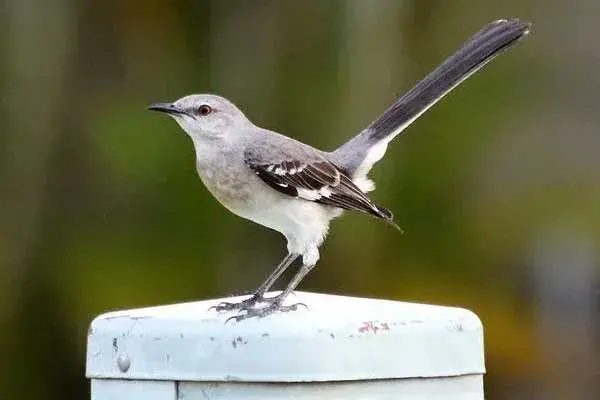
Scientific name: Mimus polyglottos
Lifespan: up to 8 years
Wingspan: 12-15 in
Wing Stripes: Large white stripes on the bottoms and tops of the wings, visible in flight
Native to: USA, Canada, and Mexico
The northern mockingbird is a gray bird with white stripes on wings and tail.
During the flight, large white patches on the black wings and tail are easy to spot. Those wing-bars have a dual purpose: to show off during the mating season and to flash them when defending their territory against some snakes and hawks.
The northern mockingbird can be commonly found on tall shrubs or tree branches of forest edges, backyards, and parks. It is the state bird of Arkansas, Florida, Mississippi, Tennessee, and Texas.
This medium-sized songbird can imitate chirps of up to 35 species and learn over 200 different songs in its lifetime. It is the only species out of 16 with the name “mockingbird” that is native to the United States.
Its Latin name literally translates to “many-tongued mimic.”
The northern mockingbird is a very territorial bird excellent at breeding – one female once managed to lay 27 eggs in a single season!
Northern mockingbirds are omnivores that feed on fruit, seeds, berries, and small insects, like beetles, earthworms, moths, butterflies, and bees.
Killdeer
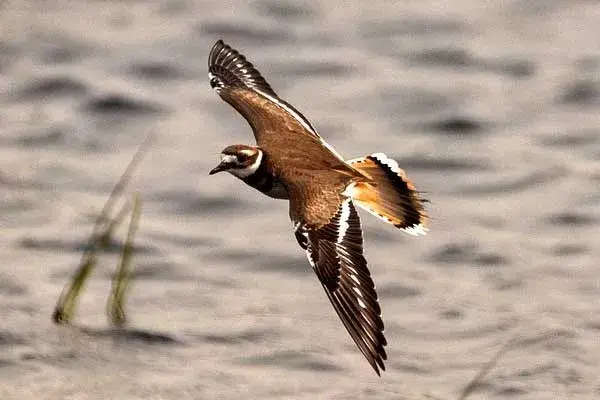
Scientific name: Charadrius vociferus
Lifespan: up to 11 years
Wingspan: 18-25 in
Wing Stripes: Bold white wing stripe at the base of the flight feathers
Native to: North America
The killdeer is a brown bird with white stripes on wings and tail. This large plover with a slender body, large, round head, large eyes, and short bill, is found in the Americas.
You can see killdeer without going to the beach can be often found on lawns, golf courses, athletic fields, and parking lots in the United States and most of Canada. Throughout the year, this shorebird can be found in Washington, especially west of the Cascades.
- Read More: 25+ examples of birds of Western Washington
Killdeer has brown plumage above, white bellow, and slender wings with conspicuous white wing stripes at their base. It is a master of distraction that might fake a ‘broken-wing‘ where it flutters along the ground in a show of injury, to distract predators from its nest.
Killdeer is an omnivore that feeds on insects, including beetles, caterpillars, grasshoppers, fly larvae, spiders, earthworms, centipedes, crayfish, snails, and some seeds.
These birds are named for the loud piercing calls that sound a little like them saying: kill-deer, kill-deer.
Eurasian Magpie
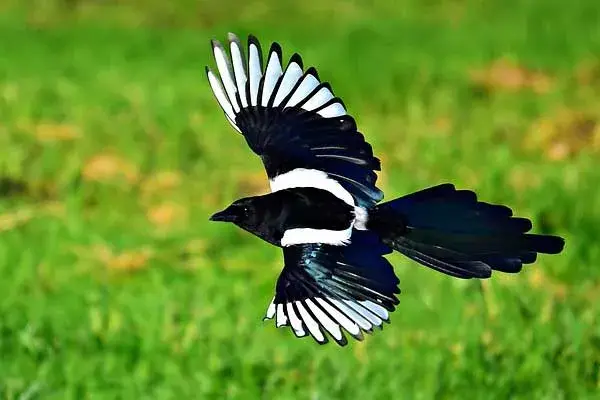
Scientific name: Pica pica
Lifespan: 2-3 years in wild
Wingspan: 20-24 in
Wing Stripes: Blue wings with white stripes
Native to: Europe, Asia, and northwest Africa
The Eurasian magpie, also known as the common magpie, is a resident breeding bird found throughout Europe, much of Asia, and Northwest Africa.
It is known for its black head, neck, and breast, green and violet sheen, white streaks on the belly, white scapulars (shoulder feathers), and conspicuous white stripes on primaries (longest wing feathers).
The common magpie is one of the most intelligent birds – it can use tools, imitate human speech, grieve, play games, work in teams, and it will recognize itself in a reflection (the mirror test). The only non-human species that have passed the mirror test are the great apes, dolphins, elephants, and magpies.
Eurasian magpies are omnivores that feed on young birds and eggs, small mammals, insects, carrion, acorns, and grain.
Interested in learning more about birds with blue wings? Check this article.
Lark Bunting
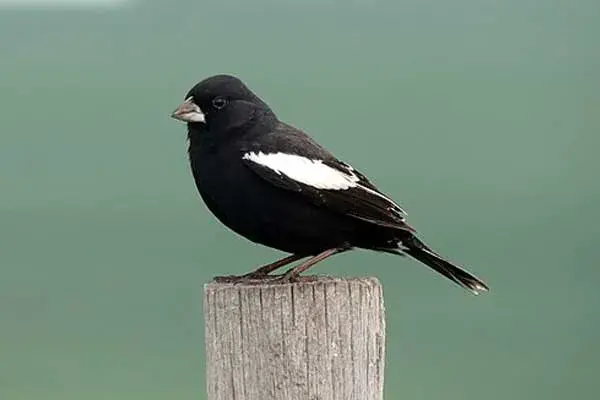
Scientific name: Calamospiza melanocorys
Lifespan: n/a
Wingspan: 10-11 in
Wing Stripes: Bold wing patches
Native to: North America
The lark bunting, a state bird of Colorado, is a medium-sized American sparrow found in grasslands of the central and western North America. It is one of the most beautiful birds on our list of birds with white wing stripes.
Breeding males are black with broad white wing bars. When winter comes, they become grayish brown with small streaks of black and white. The beak has a pale blue-gray color.
It was selected as a state bird of Colorado due to its acrobatic courtship dance, melodic song, and being native there. Lark buntings hop along the ground when foraging; they walk or run when pursuing prey.
This black bird with white stripes on wings and tail is an omnivore that feeds on seeds, insects, and some fruits.
Swamp Boubou

Scientific name: Laniarius bicolor
Lifespan: n/a
Wingspan: n/a
Wing Stripes: Clear white stripe when wings are folded
Native to: Western and southern Central Africa
The swamp boubou, also known as the Gabon boubou, is a bird native to savannah thickets, coastal scrublands, mangroves, and ravine forests of Angola, Botswana, Cameroon, Republic of the Congo, DRC, Gabon, Namibia, Zambia, and Zimbabwe.
It is black on top, white on the bottom, and the wings have a long and clear white stripe. Swamp boubou looks similar to tropical boubou; the main differences include size, bill, underparts, and singing.
The swamp boubous mate for life. Pairs will sing in a duet which is initiated by a soft guttural sound.
They are omnivores that feed on insects, worms, and occasionally small fruit.
Black-capped Chickadee

Scientific name: Poecile atricapillus
Lifespan: 2-3 years
Wingspan: 6-8 in
Wing Stripes: Hockey-stick shaped white stripes on tertial edges and secondary coverts
Native to: North America
This small nonmigratory songbird is a state bird of Massachusetts and Maine in the United States and the provincial bird of New Brunswick in Canada.
It has a short neck, large head, black cap and bib, and gray wings that are edged with white patches.
Black-caped chickadees got the name for the black caps on their heads and the distinctive “chickadee-dee-dee” calls.
They are one of the more useful birds in the orchard or forest as the white-wing-striped chickadees eat different pests, including insect eggs, larvae, weevils, lice, sawflies, but also some snails, slugs, and spiders.
Evening Grosbeak
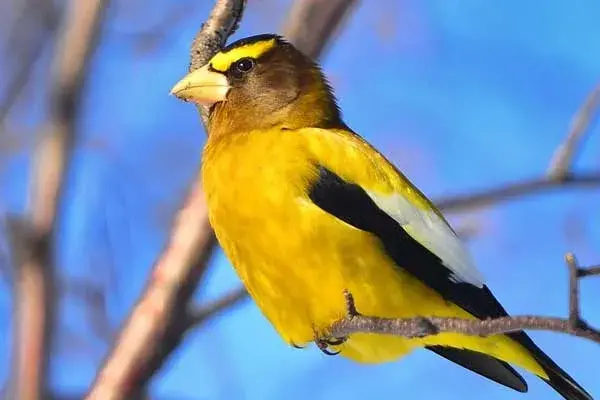
Scientific name: Coccothraustes vespertinus
Lifespan: 15-16 in
Wingspan: 12-14 in
Wing Stripes: Prominent white stripes on inner coverts and tertials of the wings
Native to: North America
The evening grosbeak is a large and stocky finch with a thick bill and neck, a full chest, and a relatively short tail. Males are big, mustard-yellow, and have very prominent gold eyebrow stripes. Speaking of stripes, they also have large black wings with large white wing patches on inner coverts and tertials.
Evening grosbeaks are primarily found in the southern parts of Canada throughout the year. Their winter range, however, includes much of the U.S.
During winter, evening Grosbeaks can be seen on roadways eating raw salt and fine gravel off of the roads. They have been also seen eating almost 100 sunflower seeds in five minutes.
White-winged Dove
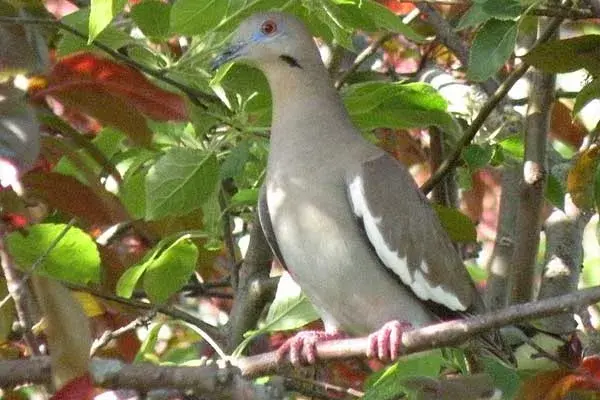
Scientific name: Zenaida asiatica
Lifespan: 10-15 years
Wingspan: 21 in
Wing Stripes: Long white stripe at the edge of the folded wings
Native to: North and Central America
White-winged dove is a semi-tropical bird found in thorny forests, streamside woodlands, and deserts. Its habitats extend from the southwestern U.S. through Mexico and Central America, into parts of western South America, and to some Caribbean islands. The bird can be also found in Central Texas and in Central Florida, where it was introduced.
Read More: 17 largest birds in Florida
White-winged dove has grayish-brown plumage and a conspicuous white patch on its wings. When perched, the white patch looks like a line along the bottom edge of the wing.
These birds can fly 25 or more miles to find water and while migrating, their flocks can have over 4,000 birds.
White-winged doves are herbivores that feed on seeds, including sunflower, milo, corn, safflower, and some berries from shrubs.
Black-and-white Warbler

Scientific name: Mniotilta varia
Lifespan: up to 11 years
Wingspan: 7-9 in
Wing Stripes: Two wide wing bars
Native to: North America
The black-and-white warbler is a medium-sized warbler (small songbird) with a fairly long, slightly downcurved beak. It breeds in northern and eastern North America.
These birds have distinctive plumage with bold black-and-white stripes over their entire bodies. The wings are black with two wide white wing stripes.
Black and white warblers are very territorial and aggressive during their breeding season, like all warblers – they’ll attack and fight with other species that enter their territory.
If you are a beginner birder, this bird is a good choice, as the black and white warbler is easy to see and recognize.
It is an insectivore (carnivore) that mostly feeds on insects, caterpillars, beetles, ants, flies, bugs, and some spiders.
Tricolored Blackbird
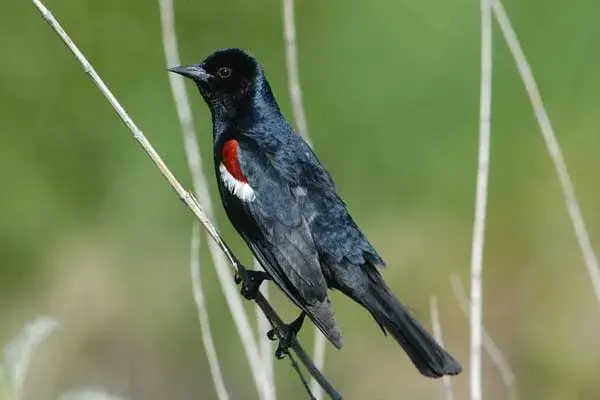
Scientific name: Agelaius tricolor
Lifespan: 13 years
Wingspan: 10-13 in
Wing Stripes: Whitish stripes on the median coverts of the wings
Native to: Pacific coast of North America
The tricolored blackbird is a gregarious medium-sized passerine bird found in the wetlands and grasslands of the Pacific states.
This large black bird with a white stripe on the wing has an interesting strategy to make its chicks leave the nest. Tricolored blackbird will fly to the nest with the food, and instead of feeding the chicks, it will fly away to encourage the young to go after it.
Male tricolored blackbirds have entirely black plumage with bright red shoulders and white-colored wing stripes. Females are dark gray-brown and have streaked bellies and backs along with cream-colored eyebrows.
Tricolored blackbirds form the largest colonies of any North American land bird, often including tens of thousands of individuals. They are omnivores feeding on grasshoppers, seeds, beetles, weevils, caterpillars, and snails.
These birds can be found in the coastal areas of the Pacific coast of North America, from Northern California in the U.S. (with occasional strays into Oregon), to upper Baja California in Mexico.
Anhinga
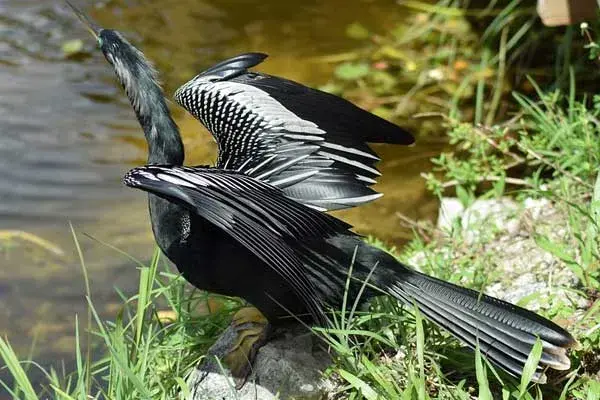
Scientific name: Anhinga anhinga
Lifespan: up to 12 years
Wingspan: 43 in
Wing Stripes: Silvery-white streaks on the wings
Native to: USA
The anhinga, also known as snakebird, darter, or water turkey, is a large and slender waterbird found in lakes, wooded swamps, marshes, and ponds. The name anhinga comes from the Brazilian Tupi language and means “devil bird” or “snake bird”.
Male anhingas are black with white streaks on their wings; females look similar but have brownish necks and heads.
They do not have waterproof wings like other birds do and while swimming, only their necks appear above water, making them look like snakes.
Anhingas are carnivores that feed on fish, insects, shrimp, crayfish, and sometimes even young alligators and snakes.
Daurian Redstart

Scientific name: Phoenicurus auroreus
Lifespan: 4 years
Wingspan: n/a
Wing Stripes: Broad white wing stripe
Native to: East Asia
The Daurian redstart is a small, active, and attractive passerine bird found mostly in East Asia. In Japan, this bird is known as jōbitaki.
Daurian redstarts are easy to recognize by the red-orange rump and tail, orange underparts, and black bills. While looking at this bird, you can clearly see a conspicuous broad, white wing patch. Females have more brown plumage.
Daurian redstarts prefer open forests, forest edges, and agricultural margins, but can be also found in parks and urban gardens. They are omnivores that feed on insects, berries, and seeds.
These birds are monogamous and the males will establish and defend the territory where they attract females.
American Goldfinch
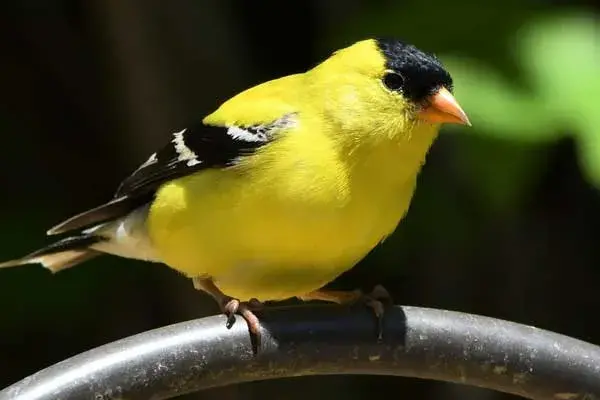
Scientific name: Spinus tristis
Lifespan: 3-6 years
Wingspan: 7.5-8.7 in
Wing Stripes: One broad white wing bar
Found In: North America
The American goldfinch is a small migratory bird with a small head, short, notched tail, and long wings with a single broad white wing stripe.
Male and female American goldfinches have a colorful carotenoid-based orange bill during the breeding season; the bill serves as an indicator of the overall health of the bird. The more saturated with orange a bill is, the higher the testosterone levels are in that specific bird.
This is helpful as it can reduce the chance of a physical battle, risk of injury, and loss of time and energy.
American goldfinches molt twice a year, once in late winter and again in late summer. They are the state bird of New Jersey, Iowa, and Washington.
Read More: 30 examples of birds that have orange-colored bills
White-browed Wagtail
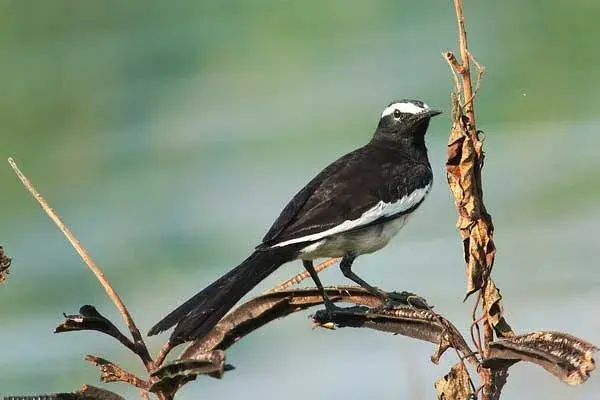
Scientific name: Motacilla maderaspatensis
Lifespan: 2 years
Wingspan: 12 in
Wing Stripes: Broad white bar on the wing when sitting or in-flight
Native to: South Asia
The white-browed wagtail, also known as the large pied wagtail, is a medium-sized bird with prominent broad white eyebrows. It has a black head, back, upper tail, broad white wings stripes, and white underparts.
The white-browed wagtail is a slender bird with a characteristically long and constantly-wagging tail, as the name suggests.
It can be found in open freshwater wetland habitats. Just like other wagtails, white-browed ones are insectivorous and feed on beetles, dragonflies, small snails, spiders, worms, crustaceans, and flies.
It got its scientific name from the Indian city of Madras (now Chennai). People used to keep white-browed tails as caged birds due to their amazing looks and singing abilities.
White-headed Woodpecker

Scientific name: Picoides albolarvatus
Lifespan: up to 4 years
Wingspan: n/a
Wing Stripes: Small white wing stripe
Native to: Western parts of North America
The white-headed woodpecker is a non-migratory woodpecker found in pine forests of the mountains of the western states and British Columbia.
These birds are black with mostly white heads and white stripes on the outer flight feathers (primary feathers). The white-headed woodpecker is the only North American woodpecker with a black body and a white head.
White-headed woodpeckers are a lot quieter than other woodpeckers because they pry rather than hammer tree bark. They also have a large bill; possibly as an adaptation to eat large spiny cones more easily.
White-headed woodpeckers are monogamous, they form pairs where both parents take care of the eggs, with the male doing all the nighttime work.
They are omnivores that feed on insects and pine seeds.
Read More: 25+ incredible black-and-white colored birds found in Colorado
Willet

Scientific name: Tringa semipalmata
Lifespan: up to 10 years
Wingspan: 27.5 in
Wing Stripes: Striking white stripe along each wing
Native to: North America
Willet is a large shorebird with gray or brown plumage that, when flying, displays a striking white stripe along each wing. It can be found in open beaches, bay shores, marshes, mudflats, and rocky coastal zones.
Willets breed from central Canada to northeastern California and Nevada and along the Atlantic and Gulf coasts south of Nova Scotia.
Willets, just like killdeer, will pretend to have a broken wing to move predators away from their eggs or chicks. There are two subspecies of willets: eastern willets and western willets.
Willets will use both their eyesight and their sensitive bills to hunt; this allows them to feed both during the day and at night. They are carnivores that feed on mole crabs, beetles, clams, and small fish.
American Avocet
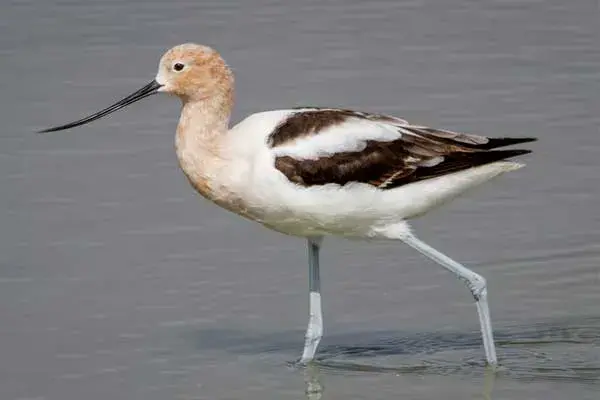
Scientific name: Recurvirostra americana
Lifespan: up to 9 years
Wingspan: 27-30 in
Wing Stripes: Broad white stripes on wings
Native to: North America
These large, slender shorebirds have long, upward-curved beaks, long necks, and round heads. They can be found in shallow fresh and saltwater wetlands, salt ponds, impoundments, and evaporation ponds.
During winter, American avocets are white overall, with black wings that have broad white wing stripes and bluish-gray legs. During the breeding season, the head and neck have a pinkish-tan color.
To feed on aquatic insects, avocets will put their beaks underwater and move them side to side to stir the water.
After hatching, the chicks can swim and feed themselves. American avocets are monogamous birds and omnivores that feed on fish, aquatic insects, seeds, and crustaceans.
White-winged Triller

Scientific name: Lalage tricolor
Lifespan: up to 3 years
Wingspan: n/a
Wing Stripes: Broad white wing stripes
Native to: Australia
White-tailed trillers are small songbirds with short beaks, black crowns and backs, white underparts, and broad white stripes on their wings.
They are found in open woodlands, forests, and tree-lined waterways of mainland Australia and on the islands to the north, including New Guinea and eastern Indonesia.
White-tailed trillers are omnivores that feed mainly on insects, fruit, seeds, and occasionally nectar. During the breeding season, they can become very noisy.
White-tailed trillers are usually monogamous birds, there have been some recorded cases of polygyny.
Magpie Lark
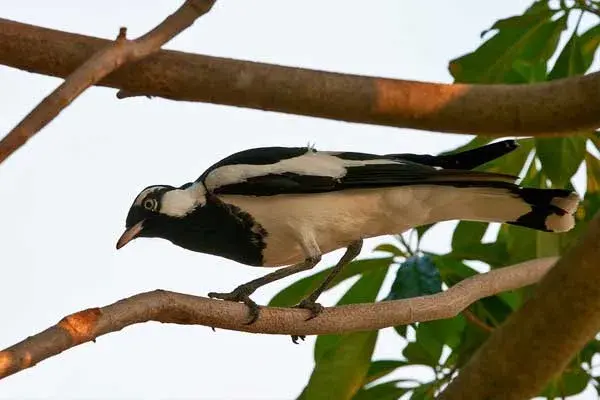
Scientific name: Grallina cyanoleuca
Lifespan: 10 years
Wingspan: n/a
Wing Stripes: White bar from the shoulder out across the wing
Native to: Australia and Asia
The Magpie lark is another beautiful bird that has white wing stripes, long, strong legs, and a fairly long, thin beak. It is a large songbird found in dry forests, savannahs, and grasslands of Australia, Timor, and southern New Guinea.
Magie larks are omnivorous birds that feed on insects, spiders, worms, crustaceans, reptiles, frogs, and occasionally seeds.
These birds will sing in a duet where each partner produces about one note a second, but a half-second apart. This makes it easy to mistake their song for a single bird singing, not two.
Magpie larks are known under many names, including Peewee, Peewit, Mudlark, or Little Magpie. They usually breed from August to February and lay 3-5 eggs.
Yellow-headed Blackbird
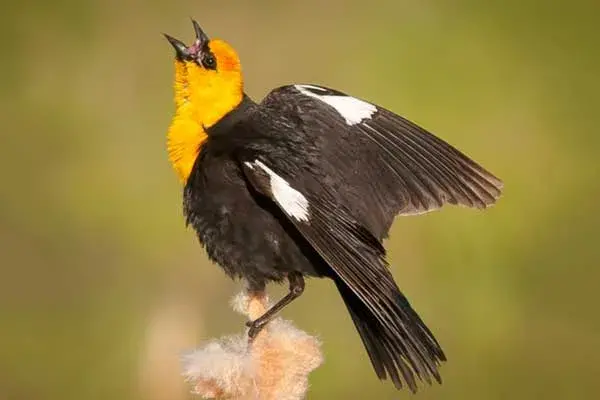
Scientific name: Xanthocephalus xanthocephalus
Lifespan: 11 years
Wingspan: 15 inches
Wing Stripes: White patches on wings
Native to: Western North America
The yellow-headed blackbird is a medium-sized blackbird very easy to recognize by its golden head and white stripes on black wings. Bill, legs, and feet are black.
The bird is pretty on the eye, but not on the ears – people describe its singing as the worst of any North American bird, they sound like a rusty farm gate opening.
Yellow-headed blackbirds are migratory birds that form large groups in winter, with some flocks estimated to be with hundreds of thousands of individuals.
Magpie Shrike
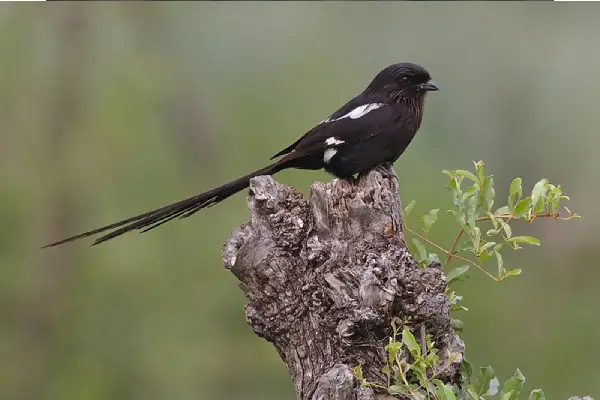
Scientific name: Urolestes melanoleucus
Lifespan: n/a
Wingspan: n/a
Wing Stripes: White patches on wings
Native to: Africa
Magpie shrikes are bulky black shrikes native to Africa.
They inhabit dry savannahs, moist savannahs, and dry shrublands of Zimbabwe, Zambia, Tanzania, South Africa, Namibia, Kenya, Mozambique, Botswana, and Angola.
Identify magpie shrikes by their mostly black plumage, wing stripes, and very long and graduated black tails that measure from 8.2 to 13.8 inches in length.
They also have white scapulars and grayish-white rumps, black beaks, and black legs and feet.
Identify these very noisy birds by their territorial whistling “kee-oo” calls, alarm “chac” calls, and “teeloo” and “tleu” sounds partners make in a duet.
Source: Lütgens, Hans (collector), CC BY-SA 4.0, via Wikimedia Commons
They love to sit upright on perches, in groups of 3-10 birds, looking for the next meal and displaying their enormous tails.
Magpie shrikes are omnivores that forage on the ground or in the air and feed on insects, small lizards, small mammals, berries, and fruit.
They are monogamous and mate for life; both mates will use twigs, grass, rootlets, and plants to build the nest, females will lay 3-5 yellowish eggs with dark spots, and males will feed them as they incubate the eggs.
As part of their courting ritual, males will bow, flick their tails, and whistle.
White-winged Widowbird
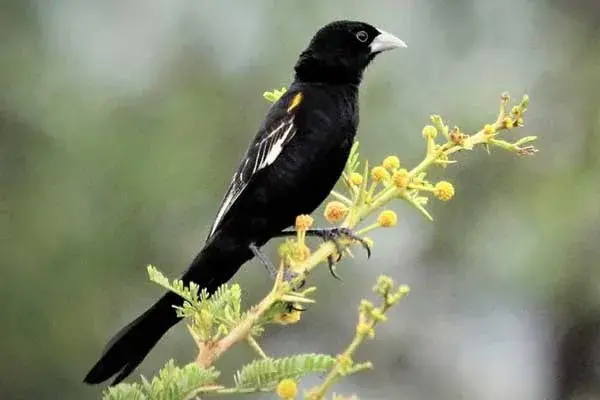
Scientific Name: Euplectes albonotatus
Lifespan: n/a
Wingspan: 5.9-7.5 in
Wing Stripes: White stripes across the wings
Native to: Africa
White-winged widowbirds are polygynous, territorial, and solitary nesting birds.
They inhabit savannas, grasslands, wetlands, as well as cultivated lands of Africa south of the Sahara.
These birds are highly sexually dimorphic during the breeding season.
Breeding male white-winged widowbirds have black plumage, pale blue beaks, brightly-colored shoulder epaulets, and white wing panels seen during flight.
Non-breeding males have buffy and streaky plumage; females do not have similar wing patterns and have pale unstreaked bellies.
Identify these birds by their “zeh-zeh” and “witz-witz” calls.
White-winged widowbirds are omnivores that feed on grass seeds, nectar, and insects.
Greater Scaup

Scientific Name: Aythya marila
Lifespan: up to 20 years
Wingspan: 28-33 in
Wing Stripes: White stripes
Native to: North America, Europe, and Asia
Greater scaups are medium-sized diving ducks with round heads and yellow eyes.
In North America, they are also known as “bluebills” due to their conspicuous dull blue bills with black tips.
Male greater scaups have black breasts, black heads with a green gloss, white stripes on wings, and white bellies and sides.
Females are brown overall with white wing markings similar to those that males have.
Identify male greater scaups by their soft nasal courting whistles and females by their raspy “arr-arr” alarm calls.
In North America, they breed in shallow lakes and ponds of Northern Canada and Alaska and winter along the coasts of North America, shores of the Great Lakes, and in the Gulf of Mexico.
Greater scaups are monogamous and females will lay 6-9 olive-brown eggs.
During winter, they will form large groups consisting of hundreds and thousands of birds.
Greater scaups are omnivores and feed on insects, mollusks, crustaceans, plants, and seeds.
They are great at diving and can go up to 23 feet below the surface.
Black-bellied Whistling Duck

Scientific Name: Dendrocygna autumnalis
Lifespan: 15 years in captivity
Wingspan: 19-22 in
Wing Stipes: Bold white stripes seen in flight
Native to: North, Central, and South America
Black-bellied whistling ducks are medium-sized ducks with long necks and legs.
They are also known as black-bellied tree ducks and generally speaking, they are one of the most erect of all ducks.
Compared to other ducks, black-bellied whistling ducks have extremely elongated legs and necks and slower flights – this is a characteristic of geese and swans and might suggest a close relationship between them.
Black-bellied whistling ducks are found in North, Central, and South America.
They are one of the two whistling duck species native to North America; in the USA, they can be seen year-round in Florida, southeast Texas, coastal parts of Alabama and Mississippi, and in Arizona during summer.
These ducks inhabit lakes, marshes, rice fields, and swamps.
Black-bellied whistling ducks have chestnut and black plumage, bright orange-pink beaks and legs, gray faces and necks, bold white wing stripes seen during flight, and white eye-rings.
Identify them also by their whistling “waa-choo” calls.
They are very social and form huge flocks outside of the breeding season, sometimes including hundreds of birds.
Black-bellied whistling ducks are monogamous and pair for many years – both parents incubate the eggs and raise the ducklings. They are cavity nesters and make their nests in tree hollows where they lay 9-18 milky white eggs.
Females might resort to “egg dumping” where they lay their eggs in the nests of other black-bellied whistling ducks.
Black-bellied whistling ducks mostly forage at night and feed on plants, insects, spiders, snails, mollusks, and tadpoles.
Scientists estimate a total population of 1-2 million birds.
Read More: Examples of African animals with stripes
Final Thoughts
This concludes our list of 20+ birds with white stripes on their wings.
Many species of birds like the willet, magpie lark, lesser nighthawk, lark bunting, white-winged dove, killdeer, American goldfinch, and anhinga are just a few that have white-striped wings.
Some of these species make wonderful pets, and white-striped wings certainly enhance their overall appearance.
Hopefully, next time you get the chance to see any of these birds in the wild, you will recognize them with ease!
And if you enjoyed our article, here’s another popular read on birds: 30+ beautiful birds with blue-colored heads.